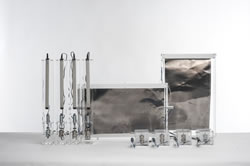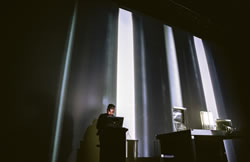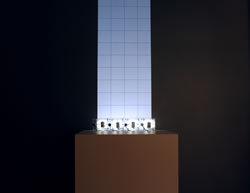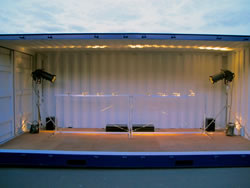Audio-Visceral Art
Sound waves and light waves in phase
Noise, Strobe Lights and Brutalism
Primarily a sound artist, I began experimenting with light while developing my Brutalist Noise Ensemble (Zareei, Carnegie and Kapur 2015). 1[1. The first-person narrative here refers to Mo Zareei, whose work is the focus of the first half of the article.] Core to my PhD dissertation (2016), the work comprises a series of sound sculptures built in appreciation of conventionally “non-beautiful” audiovisual phenomena that are ubiquitous in modern urban settings. In the ensemble, electromechanical machines such as motors and actuators and bits and pieces of metal are removed from their everyday context and turned into a medium for sonic expression (Figs. 1–2). Drawing parallels to the practice of glitch music, the sound sculptures are aimed at highlighting the potential æsthetics of the machine noise. However, here, the physicality and corporality of the sound production, and, in turn, the visual aspect of the work are at an elemental level.

In addressing this, two main strategies are employed. First, the entire sound-generating mechanism and raw material are fully exposed in transparent sculpture forms. Second, in order to further strengthen the audiovisual connectivity at the output, every sound sculpture is equipped with a light-generating element capable of producing synchronous light patterns (Fig. 3). In doing so, the æsthetic and conceptual approaches influencing the sonic aspect of the work are also extended to its visual output and the choice of light:
The choice of white light was primarily an æsthetic decision. However, metaphorically speaking, in the same way that no one dominant frequency stands out in a noisy sound, white light encompasses the widest visible frequency range and gives no advantage to any light of a particular colour. On the other hand, if machine noise is perceived as dull, tasteless, and æsthetically unpleasant in an everyday context, so is the fluorescent light. (Zareei 2016)

Every day we spend many hours in rooms saturated in fluorescent lights and filled with the hisses, hums, buzzes and clicks of the computer fans, printers, keyboards and coffee machines. If these noises are nothing but unwanted sonic by-products of our machines, the fluorescent lighting of the office space is also often a purely functional choice and not an æsthetic one. With this in mind, using such seemingly mundane audiovisual phenomena as its raw material, the Brutalist Noise Ensemble seeks to revitalize their sensory perception in parallel modes. From the visual perspective, fully transparent enclosures flaunt the æsthetically undervalued bodily existence of every component. Aurally, the raw material, which is comprised of sheer machine noise, is temporally structured through highly ordered and accessible rhythmic patterns (Video 1). In this way, as the noise is sculpted through the grid of the beat, with every pulse of sound, tightly concurrent bursts of white light connect the audible and the visible at an immediate and sensory level:
What is normally hidden inside the black box of a machine is brought back to the foreground in a fully visible and audible form, and expressed as found, i.e. undecorated and unmodified. Enclosed in entirely transparent structures, the materiality and corporeal being of all the components are clearly exhibited, exposing their usually covert (but always potential) æsthetic essence. … This austere visual quality is further highlighted through bursts of fluorescent lights, which in negotiating a fine line between mesmerising and uncomfortable, intensify the sensory experience of the works in a bold audiovisual manner. (Zareei et al. 2016)
In an effort to provide a comprehensive definition to elucidate my æsthetic motivations, I have used the term “sound-based brutalism” to refer to “sound-based works which focus on the materiality of their ‘anti-beautiful’ materials in sonic — and often also visual — forms, through a highly ordered, organised and often quantised mode of expression” (Zareei et al. 2016).
While the Brutalist Noise Ensemble is a conscious effort to explicitly realize this sound-based brutalism, the term itself was coined to provide a missing frame of reference for a large body of works with shared æsthetics:
… reductionist, minimalist and functional qualities which provide form for the provocative “anti-beauty” æsthetic wherein noise replaces the concrete and other physical materials of Brutalism, and its spatial grid is expanded to the temporal domain. (Zareei et al. 2016).

In addition to analogous formal and structural rigour, it is the idiosyncratic approach towards material and presentation that evokes the brutalist æsthetics here. Brutalist architecture is known for certain key æsthetic and ethical features, among which are the valuation and exposure of raw material, clear exposition of structure and uncompromising visual character — or, in the words of Raynard Banham, “bloody-mindedness”. Such visceral qualities are invoked through the roughness of the block-like modules of raw concrete and the striking bodily existence of a brutalist building. Sound-based brutalism, on the other hand, enables them through stroboscopic bursts of light and highly synchronous abstract visuals or basic sound-generating objects that supplement the sensory roughness of its raw sonic material, that is noise.
Both sonically and visually, what makes these works æsthetically consistent and enthralling is their direct and radically reductionist use of material, and the structural clarity of their grid-based forms: fluorescent lights, monochromic pixels and basic noise-producing (physical or digital) objects that are meticulously formalised through iterated (temporally, spatially, or both) grids made of identical or tightly similar units. …
Through reduction, repetition and clarity of sonic and visual texture and form, these works are readily accessible at one level, even if at other levels their materials are not conventionally musical or “beautiful”. This juxtaposition grants such works their unique affectivity and æsthetic, which could also be considered as a balanced tension, a frisson, or an æstheticisation of the “ugly”. (Zareei et al. 2016)
This sense of frisson is what my work relies on to stimulate a visceral appreciation for its æsthetically insipid raw material (Video 2). Creating a sensory confrontational experience is used as a strategy to heighten the visceral reception of the works’ building blocks: aural and visual phenomena that are ignored and unadorned in their everyday context. Therefore, there are always some sensory-intensified elements in the tightly synchronized aural and visual aspects of the work. The goal here is to counter the risk of inattentive exposure by playing with the boundaries of uncomfortable, accessible and pleasing. Is it blinding, hypnotic or mesmerizing? Is it a deafening cacophony or a danceable euphony? (Is it soulless concrete monstrosity, or poetic geometry of material?)
Waveforms, Physics and Minimalism
Many of the principles discussed above form the æsthetic tendencies on which my collaborations with my long-time collaborator and colleague, Jim Murphy, are based on. These tendencies can be illustrated though a brief discussion of the two most recent works developed under our collaborative project, Technical Earth.
“θr”
θr (pronounced “theta r”) is an audiovisual installation in which high-tech elements are decontextualized and repurposed in the creation of a kinetic sound and light installation. The piece consists of an array of motorized mirrors that, using microcontroller programming, are programmed to rotate synchronously with pulsating sound waves, casting beams of reflected light through the space (Fig. 4). The work is an effort to draw attention to the basic principles behind the physics of sound and light travel. Through its stripped-down and minimalist æsthetic, the kinetic sound sculpture creates an engaging and sophisticated show of light and sound from some of the most basic physical phenomena experienced in everyday life.

The work is comprised of two identical assemblies arranged side by side, with each of these “modules” consisting of an array of four motorized mirrors, a focused light source and a loudspeaker. The two light sources are placed at the end of the arrays, providing identical focused beams of light on each assembly. Using purpose-fabricated brackets, the mirrors are attached to an independently controlled rotary solenoid (an electromechanical device similar to a motor designed for use in laboratory settings in order to actuate external objects). Here, the solenoids are used to rotate the mirrors to interrupt and reflect the light beam. A microcontroller and accompanying custom-designed circuit board are used to transmit the pre-composed rhythmic patterns to drive the solenoids, while also triggering computer-generated sinusoidal sound waves that are amplified through the loudspeakers. Every mirror on each module has a corresponding sound wave with a fixed frequency that is chosen based on the relative distance of the mirror from the light source. The distance between the mirror and the light source determines the width of the reflection that is cast by the mirror. The farther away the mirror is from the light source, the less focused the beam and the wider the casting reflection and, accordingly, the greater the wavelength of the accompanying sound waves (i.e. the lower the frequency of the sound). The patterns are composed in four different sections with different rhythmic structures that morph into each other during the installation (Video 3).
In parallel to the core visual concept of the piece, which is based on reflection, the sonic material of the work is composed symmetrically between the two modules. This symmetry, which can be perceived through the stereo effect distributed between the relatively widely spaced loudspeakers, is taken into account in order to provide a coherent æsthetic, both in terms of the visual and the sonic aspects of the work.
Materiality and simplicity are recurring themes throughout the elements of θr: mechanically minimal actuators are used to pivot geometrically simple mirrors. The mirrors reflect plain white light onto the unadorned roof of the space in which θr is installed. Accompanying these elementally simple visuals is an equally fundamental audio component, consisting of pure sine tones at predictable mathematical frequency ratios. By combining these stripped-down components into a cohesive whole, a dynamic and compelling audiovisual experience is created, showing that technologically mediated material simplicity may provide insights into the coupling of light and sound that might be difficult with more baroque assemblages.
“interference [dac]”

interference [dac] is an audiovisual installation inspired by the concept of wave interference. The work consists of a miniature projector that is mounted on a loudspeaker cone. The loudspeaker is in turn mounted on a table, allowing the projector to cast its image onto a small screen down the length of the installation space (Fig. 5). The audio component of the piece (which consists of simple waveforms and digital clicks) is emitted from the loudspeaker (as well as from an auxiliary subwoofer): the loudspeaker cone’s movements cause the projector to shake synchronously with the audio, causing the projector’s image (which consist of waveform representations and simple geometric patterns) to be blurred at times of intense sonic activity. The projector and the speaker is connected to a computer. After startup and synchronization, custom-written audiovisual software generates the video and aural components of the piece.
interference [dac] explores the combination and interaction of waveforms in one medium with those of another. In the installation, sound waves affect light waves while analogue elements alter digital ones. The projector is configured to cast a series of visual waveforms and patterns onto the screen. The projected visuals are then blurred and disrupted as the projector is rattled and trembled by the movement of the loudspeaker cone (Video 4). This motion results in visual distortions that occur at audio rates, which are significantly faster and higher resolution than any available digital refresh rate. Therefore, those experiencing interference [dac] perceive the visuals being processed in a manner impossible to achieve with digital techniques alone, and are immersed in a sensory-blurring audiovisual experience. In this way, interference [dac] explores the concept of wave interference, not only as a physical phenomenon, but also through the intermingling of different mediums as well as disparate modes of communication.
Though this article has divided the works presented into two groups (those developed as solo works and those developed in collaboration with Jim Murphy), they share significant commonalities. Collectively, the works above focus upon the sensory collision of the audio and the visual. It is this act of bringing together physical phenomena in different media that is most artistically exciting to the authors: by artistically processing sonic phenomena with visual ones, and vice versa, we anticipate many more avenues of exploration at this boundary layer where sound waves are conjoined light waves in a visceral, bodily and evocative manner.
Bibliography
Zareei, Mo H. “Channelisation of Noise through a Rhythmic Grid: Brutalist mechatronic sound sculpture.” Unpublished doctoral dissertation, Victoria University of Wellington, 2016.
Zareei, Mo H., Dale A. Carnegie and Ajay Kapur. “Physical Glitch Music: A Brutalist noise ensemble.” Leonardo Music Journal 25 (December 2015) “The Politics of Sound Art,” pp. 63–67.
Zareei, Mo H., Dugal McKinnon, Dale A. Carnegie and Ajay Kapur. “Sound-Based Brutalism: An emergent æsthetic.” Organised Sound 21/1 (April 2016) “Style and Genre in Electroacoustic Music,” pp. 51–60.
Social top